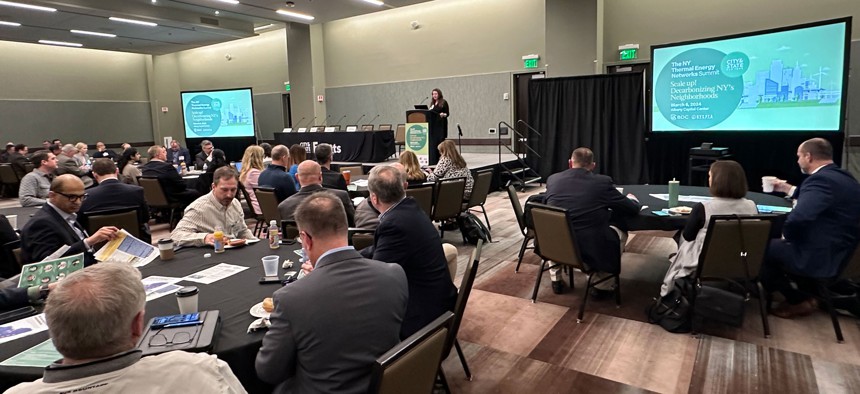Events
New York Thermal Networks Summit drives conversation on ‘revolutionary technology’
Attendees at the Albany event learned how homegrown clean heating and cooling will help the state meet its ambitious climate and clean energy transition goals.

Lisa Dix, New York director at the Building Decarbonization Coalition, welcomes attendees at the New York Thermal Networks Summit at the Albany Capital Center on Wednesday Ralph R. Ortega
Thermal Energy Networks can facilitate the decarbonization of New York’s buildings while creating family sustaining jobs, providing equitable access to clean energy and delivering scalable and replicable solutions, said organizers of the recent New York Thermal Energy Summit in Albany.
The event, hosted by the Building Decarbonization Coalition and New York State Pipes Trade Association, explored both the benefits and economic opportunities of Thermal Energy Networks, or TENs. TENs are emissions-free infrastructure projects using a shared network of underground water pipes to circulate heat in multiple buildings, according to Upgrade NY, a collaboration of unions, environmental justice advocates, building industry representatives and environmental groups. The group is calling for a healthier, more climate resilient New York through state-owned buildings and schools. Such sites would have zero emissions and create a pipeline to a clean energy workforce, the group said in materials distributed at the event, presented by City & State at the Albany Capital Center on March 6. Attendees included climate and environmental justice advocates, legislators, agency leaders, and organized labor representatives, among others from the public and private sectors.
Lisa Dix, New York director at the Building Decarbonization Coalition, kicked off the summit by inviting attendees to “talk about this revolutionary technology that will transform New York’s energy systems with homegrown, clean heating and cooling and at the scale necessary to achieve New York’s ambitious climate and clean energy transition goals.”
To prep attendees for panel discussions titled, “Level-setting: What are Thermal Energy Networks? What is the Opportunity?” and “Myth busting TENs: Myths and Misconceptions,” Dix gave an overview of the “first in nation” Utility Thermal Energy Networks and Jobs Act, or UTENJA, passed in 2022. “This bill is one of the most important efforts to date to usher in the clean energy transition for buildings at scale in the state,” she told attendees.
“UTENJA requires New York’s seven investor-owned utilities to each pilot up to five thermal energy networks across their service territories within different built environments all across our state,” she explained. “The act requires that the Public Service Commission make permanent rules and regulations for TENs, based on learnings from those pilots and to create a permanent model and new utility model to make Thermal Energy Networks and other neighborhood scale, decarbonization solutions, a permanent tool in the toolbox for our utilities to scale building decarbonization.”
The bill is unique, according to Dix, in that it incorporates mandates from the state’s climate law that directly invest 40% in underserved communities. “So 40% of the projects that are coming out under this act, at least, will be located in underserved communities where they will see the benefits,” she said, also noting that such projects also will be “constructed, operated and maintained by the union workforce in New York.”
She credited the coalition – made up of utility companies, labor groups, the buildings industry, as well as environmental and climate and environmental justice organizations for getting the act “over the finish line.”
Delivering keynote remarks at the event, Jessica Waldorf, chief of staff and director of policy implementation at the state Department of Public Service, described the state’s support for Thermal Energy Networks. She recalled witnessing the evolution of heat pump technologies in New York and the state’s role in supporting such tech, including partnering with the New York State Energy Research and Development Authority on feasibility studies conducted for the use of heat pump systems.
Waldorf also noted the legislative support Dix highlighted for Thermal Energy Networks. “So I think that's a long way of coming to the realization as partners in state government and in the private sector, that these technologies can and should play a strategic role in the state's overall decarbonization efforts,” she told attendees.
“It is an exciting time to be working in the energy sector as New York is in the midst of an accelerated transition of its energy systems,” Waldorf added, “transitioning from a society that is heavily dependent on fossil fuels, to one that is powered largely by clean electricity to achieve the state's goals and significantly reducing greenhouse gas emissions.”

NEXT STORY: How Suri Kasirer has remained New York City’s top lobbyist for the past seven years